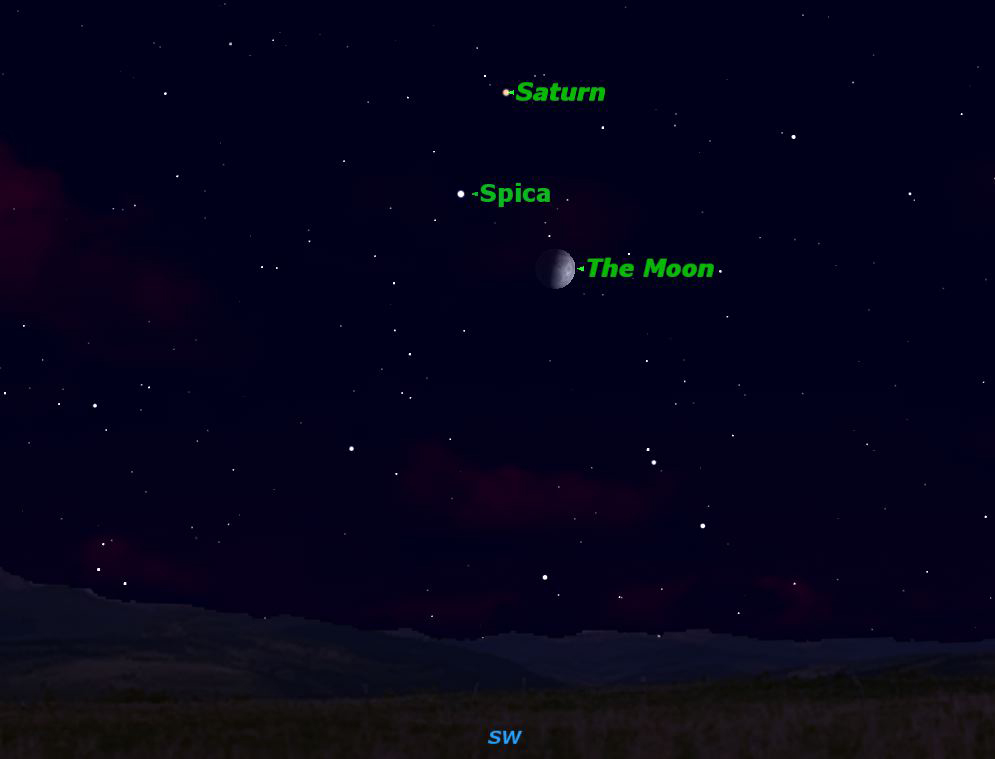Saturn, Spica and First Quarter Moon Light Up Night Sky

As the moon makes its 29.5 day journey around Earth, it has regular close encounters with planets and stars along its path. In recent weeks our satellite has passed close to Venus and Jupiter (June 17), the sun (new moon, June 19), and Mercury (June 21); this week it's Saturn's turn.
On Wednesday night, June 27, the moon will be one day past first quarter as it cruises just south of the planet Saturn and Spica, the brightest star in the constellation Virgo.
The days around first quarter are always the best for observing the moon because the terminator, the line between dark and light where the sun is rising on the moon, is perfectly placed to highlight many of the moon's most interesting features.
Saturn is a visual treat in any telescope. For a few years, its famous rings were edge-on to Earth, making them hard to see, but they have now opened up again to give Saturn its characteristic appearance. [Photos: Saturn's Glorious Rings Up Close]
Saturn's rings are made up of small fragments of rock and ice, so close together that they appear uniform from our vantage point. They look solid, but that is an illusion, as we have learned when a star passes behind them: The star continues to shine through the rings undimmed. In a telescope, see if you can spot Cassini's Division, the thin dark line which divides Saturn's rings into a brighter inner ring and a duskier outer ring. Look for the shadow of the planet on the rings, and the shadow of the rings on the planet.
Saturn's moons are a topic in themselves. No one is quite sure exactly how many moons Saturn has, because many are tiny and hard to keep track of. Titan is one of the largest moons in the solar system, the only moon with a substantial atmosphere. It is readily visible in even the smallest telescopes.
Larger telescopes will show Rhea, Tethys, Dione, and Iapetus. Because most of Saturn’s largest Moons follow orbits in the same plane as the rings, the moons can be located in any direction, unlike Jupiter’s moons which are always strung out in a straight line east and west. Use a planetarium program to identify the individual moons at the eyepiece.
Get the Space.com Newsletter
Breaking space news, the latest updates on rocket launches, skywatching events and more!
The star Spica is one of the gems of the spring sky. Just to its right is the lovely double star Porrima, Gamma Virginis. For the last several years Porrima has revolved to a point where the two stars were too close to separate even with a powerful telescope, but now it has opened up so that it can be split with a 6-inch aperture scope.
This article was provided to SPACE.com by Starry Night Education, the leader in space science curriculum solutions. Follow Starry Night on Twitter @StarryNightEdu.
Join our Space Forums to keep talking space on the latest missions, night sky and more! And if you have a news tip, correction or comment, let us know at: community@space.com.

Geoff Gaherty was Space.com's Night Sky columnist and in partnership with Starry Night software and a dedicated amateur astronomer who sought to share the wonders of the night sky with the world. Based in Canada, Geoff studied mathematics and physics at McGill University and earned a Ph.D. in anthropology from the University of Toronto, all while pursuing a passion for the night sky and serving as an astronomy communicator. He credited a partial solar eclipse observed in 1946 (at age 5) and his 1957 sighting of the Comet Arend-Roland as a teenager for sparking his interest in amateur astronomy. In 2008, Geoff won the Chant Medal from the Royal Astronomical Society of Canada, an award given to a Canadian amateur astronomer in recognition of their lifetime achievements. Sadly, Geoff passed away July 7, 2016 due to complications from a kidney transplant, but his legacy continues at Starry Night.
Most Popular


